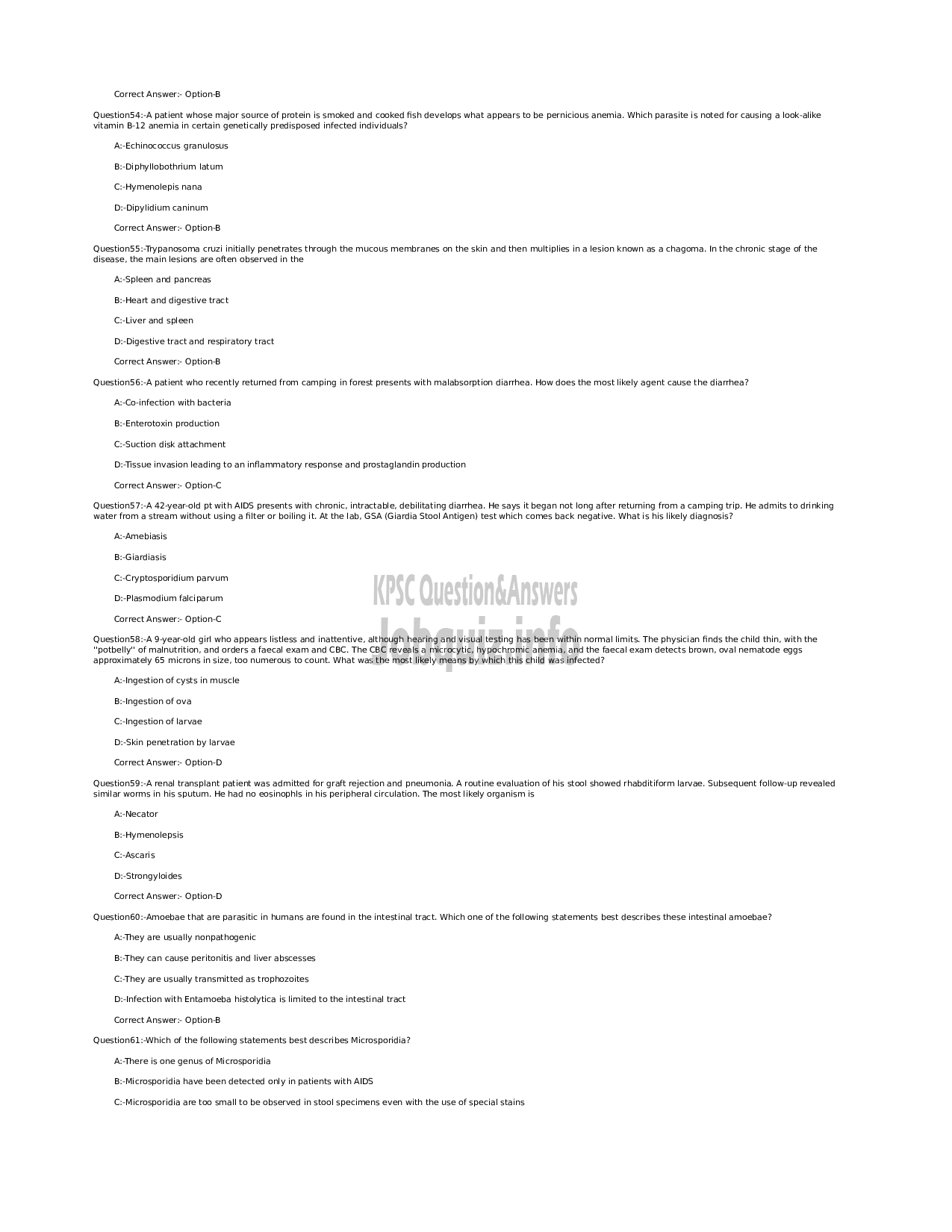Kerala PSC Previous Years Question Paper & Answer
Page:8
Below are the scanned copy of Kerala Public Service Commission (KPSC) Question Paper with answer keys of Exam Name 'Assistant Professor in Microbiology - Medical Education' And exam conducted in the year 2022. And Question paper code was '87/2022/OL'. Medium of question paper was in Malayalam or English . Booklet Alphacode was 'A'. Answer keys are given at the bottom, but we suggest you to try answering the questions yourself and compare the key along wih to check your performance. Because we would like you to do and practice by yourself.
Correct Answer: Option ®
Questions4:-A patient whose major source of protein 15 smoked and cooked fish develops what appears to be pernicious anemia. Which parasite is noted for causing a look-alike
vitamin 8-12 anemia in certain genetically predisposed infected individuals?
‘Ac Echinococcus granulosus
B:-Diphyllobothrium latum
C-Hymenolepis nana
D:-Dipylidium caninum
Correct Answer: Option ®
Question55:-Trypanosoma cruzi initially penetrates through the mucous membranes on the skin and then multiplies in a lesion known as a chagoma. In the chronic stage of the
disease, the main lesions are often observed in the
‘AcSpleen and pancreas
B:-Heart and digestive tract,
Cotiver and spleen
D-Digestive tract and respiratory tract
Correct Answer: Option ®
QuestionS6:-A patient who recently retumed from camping in forest presents with malabsorption diarthea. How does the most likely agent cause the diarrhea?
‘As Covinfection with bacteria
B:-Enterotoxin production
‘C-Suetion disk attachment
D-Tissue invasion leading to an inflammatory response and prostaglandin production
Correct Answer: Option-C
Question57:-A 42-year-old pt with AIDS presents with chronic, intractable, debilitating diarthea. He says it began not long after returning from a camping trip. He admits to drinking
water from a stream without using a filter or boiling it. At the lab, GSA (Giardia Stool Antigen) test which comes back negative. What is his likely diagnosis?
AcAmebiasis
B:-Giardiasis
C:Cryptosporidium parvum
Plasmodium falciparum
Correct Answer: Option-C
QuestionS8:-A 9-yearold gir who appears listless and inattentive, although hearing and visual testing has been within normal limits. The physician finds the child thin, with the
“potbelly" of malnutrition, and orders a faecal exam and CBC. The CBC reveals a microcytic, hypochromic anemia, and the faecal exam detects brown, oval nematode eggs
approximately 65 microns in size, too numerous to count. What was the most likely means by which this child was infected?
‘AcIngestion of cysts in muscle
B:-Ingestion of ova
C=Ingestion of larvae
Skin penetration by larvae
Correct Answer:- Option-D
Question59:-A renal transplant patient was admitted for graft rejection and pneumonia, A routine evaluation of his stool showed rhabditiform larvae. Subsequent follow-up revealed
Similar worms in his sputum. He had no easinophls in his peripheral circulation, The most likely organism is
AcNecator
B:-Hymenolepsis
CeAscaris
D:-Strongyloides
Correct Answer:- Option-D
Question60:-Amoebae that are parasitic in humans are found in the intestinal tract. Which one of the following statements best describes these intestinal amoebae?
‘AcThey are usually nonpathogenic
B:-They can cause peritonitis and liver abscesses
C-They are usually transmitted as trophozoites
Di-Infection with Entamoeba histolytica is limited to the intestinal tract
Correct Answer: Option ®
Question61::Which of the following statements best describes Microsporidia?
‘AcThere is one genus of Microsporidia
B:-Microsporidia have been detected only in patients with AIDS
C-Microsporidia are too small to be observed in stool specimens even with the use of special stains
